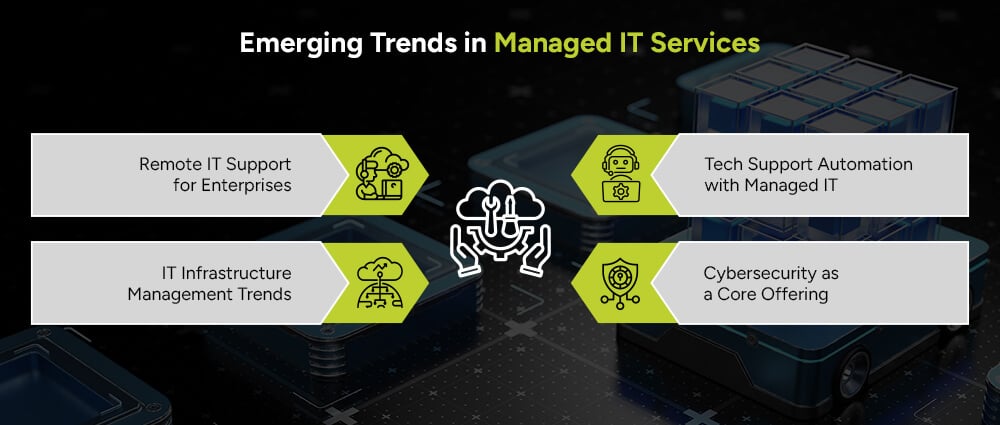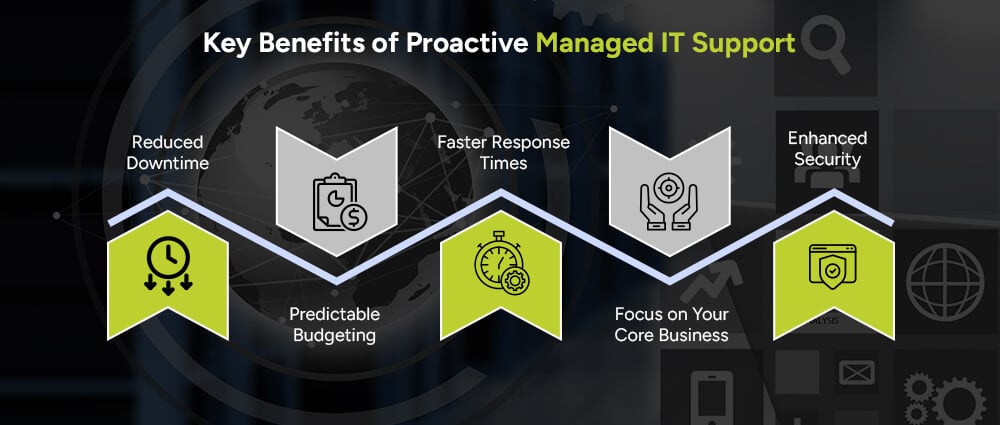At present, no matter if you’re operating startups or enterprise-level organizations, you can’t afford to fall behind when it comes to technology. With increasing cyber threats, evolving customer expectations, and rapidly changing tech landscapes, businesses need more than just a break-fix IT solution. They need a proactive, strategic partner. That’s where Managed IT Services Support comes in.
Today, we are exploring how Managed IT Services are revolutionizing tech support, the emerging trends in managed IT, and what the future outlook looks like as we head into 2025 and beyond.
Gone are the days when IT support only showed up when something broke. Traditional models worked on a break-fix system, waiting for issues to happen, then trying to fix them. But that’s like only seeing a doctor when you’re really sick, instead of going for regular checkups to prevent problems in the first place.
Managed IT Services Support flips this model on its head by offering proactive IT support. This means continuous monitoring, real-time threat detection, preventive maintenance, and round-the-clock support that helps companies avoid downtime, data loss, and costly repairs.
This proactive approach is not just beneficial, it’s becoming essential.

Let’s take a look at what’s shaping the future:
It is now a permanent feature, and has moved over from the pandemic to the present. The most common use of such services for enterprises is the availability of remote managed IT support teams, whereby issues are resolved from anywhere, anytime.
Thanks to faster internet, cloud-based tools, and advanced monitoring software development trends, tech providers can troubleshoot without being on-site.
Help desk experience revolutionized by AI and automation. It now allows automated processing of simple requests such as password resets and system updates to free the technician from simple stuff in order to process more complex cases.
Automated patch management, systems alerts and part of this new breed chatbots comprise this new wave.
Modern businesses run on hybrid infrastructures, part on-premise, part cloud. Managing this mix is becoming a top priority. Managed IT providers are focusing on integrated dashboards, performance analytics, and smarter infrastructure monitoring tools to simplify operations and increase uptime.
As threats grow more sophisticated, cybersecurity is no longer optional. The managed IT services future outlook includes deeper integration of endpoint protection, firewall management, zero-trust policies, and HIPAA-compliant and compliance-driven support customized to industries like healthcare cloud migration, and finance cloud managed services.
IT support outsourcing in 2025 is less about saving money and more about gaining expertise and agility. Companies want access to top-tier talent without hiring full in-house teams. From Healthcare IT support services in Dubai to Real estate support, every industry is moving forward. With outsourcing, you also get 24/7 support, coverage across time zones, and scalable solutions that can grow with your business.
Moreover, outsourcing ensures you’re not tied to outdated systems or reactive models. You get proactive IT support, strategic upgrades, and access to the latest tools, all bundled into a predictable monthly cost.

There are many key benefits of managed IT support services, here are some that can elevate the state of your business and take you to the next level:
In a proactive kind of IT support, the upside is that major disruptions are actually prevented by spotting and handling problems before they arise. Instead of waiting for an issue to pop up, IT has an eye on the workability of any aspect of the technology ecosystem, addressing small glitches before they turn into enterprise-wide headaches.
This means lesser crashes, lesser waiting times, and more time to focus on primary work for your team.
Nobody likes surprise and big expenditures usually associated with an unexpected breakdown of IT. Whereas proactive means systems are priced out clearly and remain cost-consistent.
All scheduled maintenance is also within the scope, so thanks to this approach, emergency repair bills or sudden upgrades won’t catch you off guard. When IT expenses are predictable and controllable, budgeting is easy.
When something does go wrong, you don’t want to wait hours, or worse, days, for help. Proactive IT observes the systems 24/7 from the comfort of your house; when there is a suspicious flag raised, someone will immediately attend to it. It means fixed in lesser time, less waiting, and, importantly, more productivity time.
The cost of time and energy involved in maintaining an in-house IT team is quite high, especially for those who are not IT-savvy. With proactive support, the professionals keep everything running smoothly in the background, leaving you and your team with time to grow your business rather than fixing issues with technology.
Cyber threats are constantly evolving, but proactive IT support includes continuous threat monitoring, early detection, and fast response to anything suspicious. It’s like having a digital security guard watching over your business day and night, protecting your data, your clients, and your reputation from harm.
The future of IT support lies in adaptability, security, and intelligence. As companies increasingly rely on digital operations, managed IT services will continue evolving to meet those demands.
Ultimately, managed IT services support is becoming less of a vendor relationship and more of a partnership in business growth.
As technology becomes more complex, the need for smarter, more flexible IT support grows. Managed IT Services Support isn’t just a trend, it’s a necessity for businesses that want to stay secure, agile, and future-ready. By embracing these emerging trends and partnering with the right provider, companies can thrive in the evolving tech landscape of 2025 and beyond.
Managed services bring immense value by providing proactive IT support, minimizing downtime, enhancing cybersecurity, customizing to industries like cybersecurity solutions for healthcare sector, and offering access to expert-level service at a predictable cost. They allow businesses to focus on core goals while leaving the tech management to specialists.
The future of IT support is intelligent, automated, and remote. Trends like tech support automation, AI integration, cloud-based infrastructure, and enhanced cybersecurity will define the next generation of managed medical practice IT support. Personalization and proactive problem-solving will be key.
Managed IT services typically include: